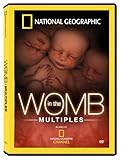
Average Reviews:

(More customer reviews)This documentary follows the multiple pregnancies of three different women, from conception to shortly after the birth. Rachel (the only one who isn't a first-time mother) is having fraternal twins (a boy and a girl), Jennifer is having triplets (two identical boys plus one fraternal brother who was conceived on a different day), and Julie is having identical quads (girls). All three of these sets of multiples were conceived naturally, even Julie's (the odds of having naturally-conceived identical quads are one in eight million!). Using cutting-edge 4-D technology, we're able to get a fascinating look at just what goes on in the womb during these gestational periods. Not only do we get to see what the embryos/fetuses look like as they develop, but we also get to see the kinds of interactions they have with one another, interactions that vary from up-close and personal (if they're together in the same amnion and chorion, no barriers between them) to only able to feel one another through membranes if they're in separate amnions and chorions.
This documentary is loaded with just about everything you ever might have wanted to know about multiple pregnancies. Topics include the different types of twinning, what might cause conjoined twins, how interactions in utero continue playing out after birth (such as one set of twins in which the dominant twin often kicked his brother, who put his head down on the placenta for comfort instead of fighting back; as they grew up, the submissive twin would go to his room and put his head on the blanket when bullied by the dominant one), why older women are more prone to naturally-conceived multiples (one theory is that the eggs a woman is left with by then are weakened by age and therefore more likely to split), why many twins are mirror images of one another, and how a woman's height affects how close to term she can bring a multiple pregnancy. I knew that sometimes triplets can be carried almost to full term and delivered naturally, but didn't know that the odds are greater for such a thing if the mother is taller. Jennifer, the triplets' mother, was almost six feet tall, though she ended up having to have a C-section that wasn't as close to full term as had been hoped.
In addition to shining a light on the amazing process of development a fetus goes through, it also lets one into the mysterious world of what it's like to actually be in there, and to be on the same amazing journey with one, two, or even three other companions. One can't help but wonder how much these newborn multiples remember of their time in the womb, when they formed a bond like no other with their womb-mates.
Click Here to see more reviews about: National Geographic: In the Womb - Multiples (2006)
Expanding on the critically acclaimed special, In the Womb, National Geographic explores the extraordinary and fragile world of twins, triplets and quadruplets in utero. Featuring amazing 4-D ultrasound images and revolutionary new fetal imaging techniques, this remarkable new special travels inside the womb to witness tiny fetuses as they grow and begin to interact with each other.
Click here for more information about National Geographic: In the Womb - Multiples (2006)

No comments:
Post a Comment